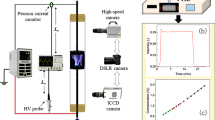Abstract
Given the operational constraints of aerospace ground equipments (AGE), the non‐thermal plasma discharge (NTPD) has been identified as a promising technology for their NOx removal. As part of a program to optimize an NTPD system for this particular application, an investigation of the effect of discharge gap spacing on the electrical and chemical processes that occur in NTPDs was initiated. A number of experiments were performed to examine how the gap spacing affects the NO removal efficiency, discharge characteristics, and chemical reactions in a NTPD device. Gap spacings ranging from 0.8 to 4.0 mm were investigated in this study. An optimum gap spacing for NO removal was observed at approximately 2 mm and, based on the experimental data, a physical explanation for the optimum was developed. The experiments, results and conclusions are discusssed in detail in this paper.
Similar content being viewed by others
References
1. M. Bertholot, Compt. Rend. 1876(82), 1357–1361.
2. B. M. Penetrante and S. E. Schultheis (eds.), Non-Thermal Plasma Techniques for Pollution Control: Parts A and B, Springer-Verlag, Berlin, Germany, 1994.
3. B. Eliasson and U. Kogelschatz, IEE Trans. Plasma Sci. 19(2), 309–322 (1991).
4. G. E. Vogtlin and B. M. Penetrante, Non-Thermal Plasma Techniques for Pollution Control Part B, 1994, pp. 187–198.
5. L. A. Rosocha, G. K. Anderson, L. A. Bechtold, J. J. Coogan, H. G. Heck, M. Kang, W. H. McCulla, R. A. Tennant, and P. J. Wantuck, Non-Thermal Plasma Techniques for Pollution Control Part B, 1994, pp. 281–308.
6. S. Masuda, Non-Thermal Plasma Techniques for Pollution Control Part B, 1994, pp. 199–209.
7. Z. Falkenstein and J. J. Coogan, J. Phys. D: Appl. Phys. 30, 817–825 (1997).
8. J. W. Rogers, A. J. Nejezchleb, G. E. Rolader, S. P. Federle, D. M. Littrell, W. C. Neely, and E. I. Newhouse, J. Adv. Oxid. Tech. 2(2), 100–105 (1997).
9. O. Wolf, S. Listl, and M. Neiger, Proc. HAKONE V, Milovy, Czech Republic, 1996, pp. 325–328.
10. D. Braun, U. Küchler, and G. Pietsch, J. Phys. D: Appl. Phys. 24, 564–572 (1991).
11. Z. Wang, The Reaction Mechanism of NOx Removal by Non-thermal Plasma Discharge, Ph.D Thesis, Department of Chemistry, Clark Atlanta University, Atlanta, Georgia, USA, (1999).
12. J. S. Townsend, Electricity in Gases, O.U.P., 1915.
Author information
Authors and Affiliations
Rights and permissions
About this article
Cite this article
Wang, Z., Yeboah, Y., Bai, T. et al. Gap Space Optimization for NO Removal in a Non‐thermal Plasma Discharge. Plasma Chem Plasma Process 24, 405–420 (2004). https://doi.org/10.1007/s11090-004-2276-y
Issue Date:
DOI: https://doi.org/10.1007/s11090-004-2276-y




